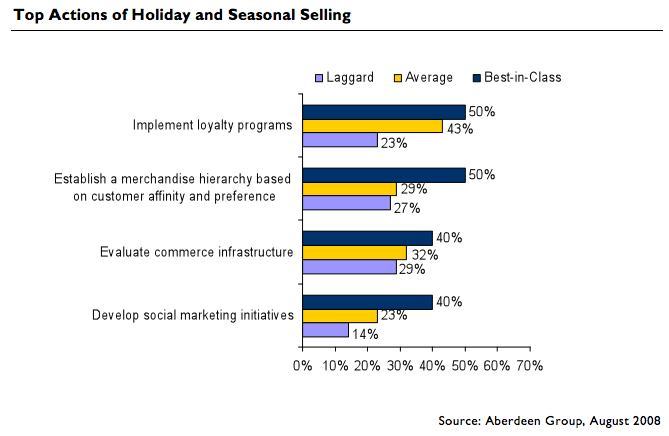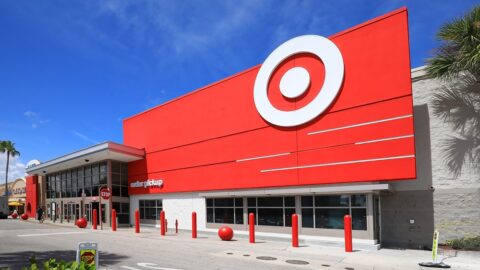Several research reports released last week showed the undeniable reality check that awaits retailers this holiday season. Most merchants will be faced with the slowest sales growth since 1991. In order to remain solvent and competitive beyond this critical further quarter period, analysts stress retailers must get closer to their customers by adopting online tools and analytics capabilities.
The bad news about holiday sales predictions came from several fronts. TNS/Retail Forward estimated that retail sales this November and December will increase just 1.5%. Deloitte was a bit more optimistic, predicting a 2.5% to 3% increase. That would make the 2008 holiday season the worst for retailers since 1991. However, it is also not a sharp drop taken on an annual basis. Deloitte says holiday sales hit a 10-year high in 2005, surging 7%. In 2006, sales rose 3.8%, and last year, they were up 2.7%.
TNS senior economist Frank Badillo said that the economy is the culprit and will push consumer spending toward discount and mass retail. “Our top-line forecast separates into two distinct groups—the leaders and the laggards,” Badillo states. “Sustaining above-average growth will be non-store and mass retailers. They will see combined growth near 6.0% in the fourth quarter. Continuing to troll the depths will be the homegoods and softgoods retailers where growth is expected to decline 1% or more.”
In recent years, e-commerce has come to the rescue providing double-digit growth for retailers that were suffering offline. But that growth may not be so easy to come by this year either. A new report from Shop.org and Forrester Research shows “cautious optimism” among its members. The 25% growth rate predicted earlier this year may still be reachable from some companies the report says, but specific growth rates were noticeably absent.
About one-third (35%) of online retailers surveyed said they expect their online business to perform better than expected in the next 12 months, while another third (33%) anticipate their online business will perform the same as expected.. According to the report, 81% of online retailers surveyed reported that their eCommerce business was profitable in 2007, and 75% were also more profitable last year than in 2006. Almost half (49%) of online retailers said that their average conversion rate in 2007 was higher than in 2006, and that 36% of total sales for the online retailers were driven by repeat customers—higher than in 2006. However, due to their outlook for the US economy, 37% of survey respondents noted that they’ve lowered their expectations for their online business performance in the next 12 months.
The report also issued something of a profit warning: “Retailers must still execute well to capture possible sales. Additionally, it cautions that those sales may not necessarily be the highest-margin revenue due to increased input costs and the pressure to offer promotions such as free shipping,” it said.
THE NEW PLAYBOOK
For retailers looking for a way to combat these new realities, Aberdeen Group released a new research report focused on the strategies necessary for driving holiday business. The Aberdeen study, released just days before the slew of bad news on Wall Street, showed that “Best-in-Class companies optimally manage merchandise, customers, and data as key determinants for driving successful holiday business.” On average at least 50% of the Best-in-Class respondents focus on customer-facing and back-end technology tools that support online channel sales as e-commerce becomes more significant for topline gains during peak selling seasons, according to Aberdeen.
The data from the report, “The Complete Mantra for Driving Holiday Business in 2008, 2009 and Beyond,” shows that 55% of leading retailers see the need to counter competitive selling strategies as the top holiday pressure. To try and outpace their competitors, 50% of leading retailers are using such advanced online tools as search and comparative shopping tools, dynamic web content management, online analytics, and social marketing tools.
The report showed a fairly big divide between the Best-in-Class companies from the rest of the pack in terms of their approach to planning and measuring the key holiday period. 70% of Best-in-Class companies utilize standardized metrics to measure Holiday performance effectiveness versus 41% of Average and 33% of Laggard companies. Accordingly, a critical enabler for managing seasonal selling is the ability to measure key associated metrics like sales comp, product margin erosion, cost to serve, and total cost of goods sold, the report found.
The top action for holiday selling optimization was developing loyalty programs, which topped the list of best-in-class respondents. 40% said they were consistently evaluating commerce infrastructure to accomplish loyalty and analytics goals. The need for technology and infrastructure is driven by the increasing complexity of e-commerce applications, as well as increased cross-channel sales. Product inventory and customer data must be managed across- channels in order to drive customer loyalty for the future and maximize sales for the short term.
“These content-rich, immersive sites are compelling, but require more bandwidth than standard, static pages,” said Aberdeen senior analyst Ben Ream. “Leading retailers are taking a preemptive approach, and measuring system capacity against site application demands.”













